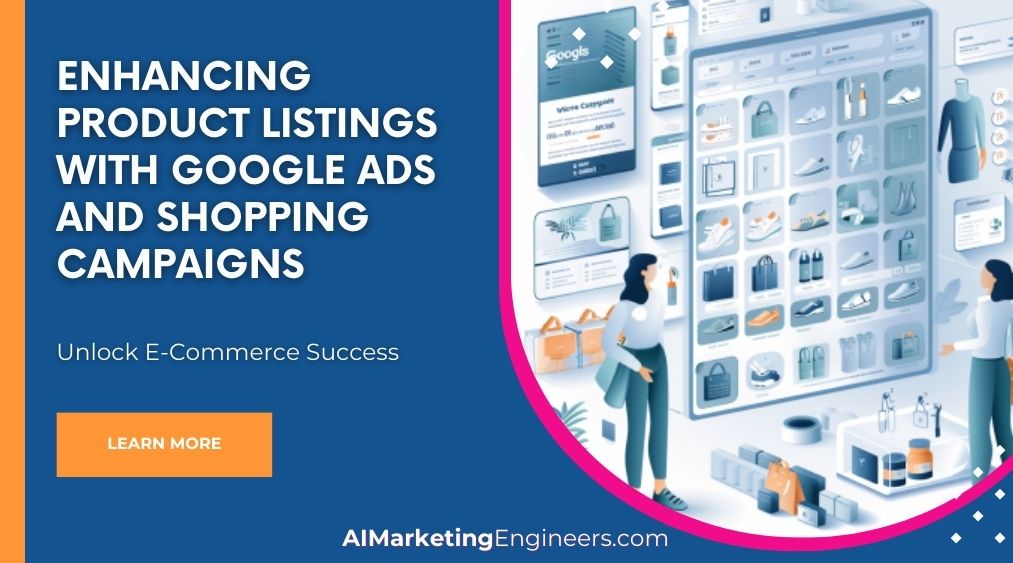Key Takeaways
✅ Improved Visibility: Gain an edge by utilizing Google Ads and Shopping Campaigns. Statistics show businesses seen on Google Search and Shopping have a 30% higher chance of capturing consumer interest. Let's boost your product's search visibility and draw in more potential customers.
✅ Personalized Experience: Customizing how customers view your products can increase sales by up to 20%. Use audience targeting to show the right products to the right people at the right time, creating a shopping experience that feels tailor-made.
✅ Data-Driven Insights: With access to Google's analytics, you can tweak your listings based on concrete data, possibly boosting your conversion rates by up to 50%. Let's turn data into dollars.

Introduction
Imagine this: you have a great product, but it’s like a billboard in the desert—barely anyone sees it. How do you move it into Times Square? This is where enhancing product listings with Google Ads and Shopping Campaigns comes into play. It's about making your product the main attraction for online shoppers!
From a comprehensive understanding of Google Shopping Campaigns' distinct advantages to a deep dive into optimizing product listings that scream "buy me," this article is your ticket to increased visibility and conversions. We'll walk you through the nitty-gritty of setting up your campaigns, share strategies on outbidding competitors without burning cash, and reveal advanced tactics to keep your listings at the zenith of online shopping.
It doesn't matter if you're just dipping your toes into e-commerce or looking to supersize your digital store's presence; actionable insights lie ahead. These are ground-breaking strategies that have transformed average Joe products into household names. So, are you ready to lift the curtain on these enhancing product listings secrets and maximize revenue streams? The show is about to begin, and trust me, it'll be anything but business as usual.

Top Statistics
| Statistic | Insight |
|---|---|
| Global E-commerce Sales: Expected to reach $4.9 trillion in 2021. (Source: eMarketer, 2021) | This staggering figure is a testament to the sheer size of the online marketplace, with Google Shopping playing an essential role in driving e-commerce evolution. |
| Google Shopping Ad Spend: Represents 76.4% of retail search ad spend in the US. (Source: Merkle, 2021) | This statistic highlights the dominant share of Google Shopping in the digital advertising space, outpacing competitors like Amazon. |
| Google Shopping CTR and CPC: An average CTR of 0.66% and a CPC of $0.66. (Source: WordStream, 2021) | The balance between CTR and CPC showcases the cost-effectiveness and potential return on investment when optimizing product listings. |
| Mobile Device Usage: Accounts for 60% of Google Shopping clicks and 51% of conversions. (Source: Merkle, 2021) | A clear indication that optimizing product listings for mobile users is critical in capturing the growing segment of on-the-go consumers. |
| Product Search Trends: 55% of online shoppers use Google, with 48% beginning their product searches there. (Source: Think with Google, 2020) | This shows the immense influence Google has on shoppers' buying journeys, emphasizing why a strong presence on Google Shopping can be a game-changer for businesses. |
Understanding Google Shopping Campaigns
Google Shopping Campaigns serve as a specialized avenue for promoting your products directly within Google search results. Unlike traditional search ads that rely heavily on text, Google Shopping showcases products through richer visuals and detailed information before a potential buyer even clicks on your listing. The main draw is the format – product images, titles, and prices are displayed prominently, grabbing attention instantly. The core benefit of these campaigns lies in their ability to place your products in front of consumers with high intent, often leading to better click-through rates and conversion numbers as compared to standard text ads. E-commerce businesses greatly benefit from this type of targeted exposure.

Optimizing Product Listings
Creating a high-performing Google Shopping Campaign begins with the meticulous crafting of product listings. The success hinges on a trifecta: compelling product titles, informative descriptions, and high-quality imagery. Titles should be precise yet descriptive, including key details like brand, size, and color to ensure they pop up in relevant searches. Descriptions backed with essential product attributes offer a clearer picture to shoppers, and crisp, clear images solidify their interest. Moreover, a well-maintained data feed that consistently delivers accurate and high-quality product information to Google is a decisive component in this algorithm-driven arena.
Setting Up a Google Shopping Campaign
Ready to put your products on display? Setting up a Google Shopping Campaign entails linking your Google Merchant Center account with your Google Ads account. Herein lies the essence of the process – a product feed that includes detailed information about the items you're selling. This feed is the roadmap Google uses to construct your ads. Once these elements are knitted together, establish your campaign goals, whether focusing on maximizing clicks, driving conversion value, or simply spreading the word about your latest offerings.
Bidding Strategies and Campaign Management
Deciding on a bidding strategy can feel like navigating a maze. However, the options are plentiful, from cost-per-click (CPC) where you pay for each click your ad receives, to enhanced CPC, where Google adjusts your bids to maximize conversions. Smart bidding takes it a step further, using machine learning to optimize for conversions or conversion value in each and every auction. To keep your campaign in tip-top shape, regular tweaks based on performance data and insights gleaned from Google’s analytical tools are necessary. Freshen up your approach by testing new strategies and refining the ones that show promise.

Advanced Tactics for Google Shopping Campaigns
To outsmart competitors, businesses must go beyond the basics. Engage in fierce competitor analysis and comprehensive market research to identify opportunities and threats. Tools like negative keywords and search query reports safeguard your campaign from irrelevant traffic and wasted spend. On another front, remarketing and audience targeting strategies are crucial for reconnecting with individuals who have shown interest in your products but haven't made a purchase. A precise remarketing campaign can turn those indecisions into tangible sales.
The secret to thriving in the competitive e-commerce space lies in a robust online presence bolstered by well-executed Google Ads and Shopping Campaigns. By mastering these platforms, enhancing your product listings, and staying agile in your campaign management, your e-commerce business can enjoy a slice of the digital pie that continues to grow each year. Remember, mighty oaks from little acorns grow – start small, learn continuously, and your efforts in the digital marketplace will flourish.
AI Marketing Engineers Recommendation
Recommendation 1: Optimize Product Titles and Descriptions for Search Intent: Ensure that product titles and descriptions within your Google Ads and Shopping Campaigns are optimized for what your potential customers are actually searching for. Data shows that product listings with clear, descriptive, and keyword-focused titles have a higher click-through rate. For instance, a study by Adlucent found that 70% of shoppers are more likely to click on a product that includes keywords matching their search query. Include brand, product type, size, color, and important attributes to make sure your listings match user intent as closely as possible.
Recommendation 2: Leverage High-Quality Visuals and Videos: With the increasing importance of visual content in online shopping, invest in high-resolution images and videos for your product listings. This strategic approach taps into the trend where engaging visuals can significantly boost the performance of your listings. Google reports that more than 50% of online shoppers said that images helped them decide what to buy. Incorporate 360-degree product views and video demonstrations where applicable to give potential customers the best virtual product experience, influencing their decision-making process positively.
Recommendation 3: Utilize Google Merchant Center's Advanced Features: Take full advantage of the Google Merchant Center's latest features to enhance your product listings. Use Merchant Center tools such as automatic item updates, which keep your product information accurate without requiring manual adjustments, and product data feed optimization, which helps to identify and fix any issues with your product listings. Furthermore, the "Price Competitiveness" insight tab provides valuable data on how your pricing stands against competitors, allowing you to make informed pricing decisions. These tools have proved to be beneficial for retailers, with Google stating that complete and accurate product data can increase the likelihood of your product showing up in searches by 40%.

Relevant Links
- Mastering Google Shopping: Boosting E-Commerce Success
- Conquer Digital China: Master WeChat and Crack the Baidu Code
- Revolutionize Your Marketing with China's Short-Video Powerhouses
- Capturing South Korea's Digital Heart: Trends and Strategies
- SEO Success in South Korea: Winning Strategies for E-Commerce
Conclusion
Through the course of this article, we've unpacked the nitty-gritty of maximizing your online presence with the help of Google Ads and Shopping Campaigns. Let's reflect on the fresh insight that's poised to transform your approach to online marketing. Google Shopping Campaigns stand out as an indispensable tool for e-commerce businesses, offering a visual and dynamic way to present products directly to potential customers. The biggest takeaway? Optimizing product listings isn’t just a box to tick; it’s a robust strategy to win the digital shelf space.
The not-so-secret sauce to prowess in Google Shopping involves meticulously crafting product titles, descriptions, and images to make them more appealing and relevant to consumer searches. High-quality data feeds and astute product attributes fill in the gaps, serving as the underpinning for effective campaigns. Just setting things up isn't enough, though. Ongoing campaign management paired with smart bidding strategies can reduce waste and enhance visibility, bringing your products into the limelight right when shoppers are ready to buy.
But progress doesn’t put its feet up — advanced tactics like competitor analysis, negative keywords, and retargeting should be part of your ever-evolving playbook. Keep your finger on the pulse, utilize analytics to drive decisions, and remember that innovation is best buddied with experimentation. Could your e-commerce engine be tuned even better? What untapped tools and techniques could catapult you ahead of the curve?
Whether you're a seasoned pro or new to the game, harnessing the full potential of Google Shopping is a continual journey. As consumer behavior shifts and technology advances, staying ahead demands that you stay informed and agile. So why not dive deeper, test new strategies, and keep learning? The future of your online success story might just be a well-plotted campaign away.

FAQs
Question 1: What are Google Shopping Campaigns?
Answer: Google Shopping Campaigns are a tool that businesses use to flash their products on various Google platforms, like Google Search or Google Images. It's like putting your products in the shop window, but the shop is Google, and it's open 24/7, all over the world.
Question 2: How do I create a Google Shopping Campaign?
Answer: Roll up your sleeves and dive into setting up a Google Merchant Center account. Upload a list of stuff you sell, you know, a data feed of your products, and link it over to your Google Ads account. From there, you can start a new campaign, decide how much you want to spend, and figure out how you want to bid for ads.
Question 3: What is a product data feed, and how do I create one?
Answer: Think of a product data feed as the DNA of your product listings. It's a file with all the juicy details: titles, descriptions, images, the works. You can make one using a simple spreadsheet or some fancy third-party tools that play nice with Google Merchant Center.
Question 4: How can I optimize my product listings for better performance?
Answer: Keep your product info on point and up to the minute, flaunt some snazzy product pics, and draw in people with irresistible titles and descriptions. Oh, and don't forget those magic words—keywords!
Question 5: What is the difference between Google Shopping Ads and Google Search Ads?
Answer: Here's the scoop: Google Shopping Ads are all about visuals. They show images, prices, and bits of info, whereas Google Search Ads are those text ads you see on search pages, usually at the top or bottom.
Question 6: How can I improve my Google Shopping Campaign performance?
Answer: Keep your eyes peeled on how your campaign's doing, tweak bids and budgets, experiment with different ad types and targets, and use negative keywords to shoo away searches that don't align with your products.
Question 7: What is the difference between Smart Shopping and Standard Shopping Campaigns?
Answer: Smart Shopping Campaigns are like autopilot, using some clever algorithms to set bids and targets. On the other hand, Standard Shopping Campaigns let you take the wheel and make all the decisions.
Question 8: How can I track the performance of my Google Shopping Campaigns?
Answer: Google's got tools in Ads reporting that lay out all the stats you need—clicks, eyeballs, sales and more. You can also peek at Google Analytics to see how your ads are playing with your website's performance.
Question 9: What are some advanced strategies for optimizing Google Shopping Campaigns?
Answer: Looking to up your game? Consider tactics like dynamic remarketing to reel back in visitors, categorizing products for clarity, targeting specific customers, and even listing your products on Google Shopping Actions to let people buy them directly through Google.
Question 10: What are some best practices for creating effective Google Shopping Ads?
Answer: Put your best foot forward with stellar images, captivating titles and descriptions, use relevant keywords, and lure in shoppers with deals and offers they can't resist.

Academic References
- MacLaggan, W. (2018). "Optimizing Google Shopping Campaigns: A Comprehensive Guide." Marin Software. This article serves as a resource for understanding how to enhance Google Shopping campaigns, shedding light on the effectiveness of well-crafted product data, bid strategies, and the use of ad extensions to improve click-through and conversion rates.
- Orendorff, A. (2021). "Google Shopping Ads: The Ultimate Guide." Search Engine Journal. Orendorff offers a deep dive into the world of Google Shopping Ads covering the essentials of setting up, managing, and optimizing product listings. His guide underscores the value of fine-tuning your product feed and deploying smart bidding tactics for better results.
- Gilbert, D. (2019). "Google Shopping Ads: A Complete Guide to Setting Up and Optimizing Your Campaigns." Brainlabs. In his comprehensive guide, Gilbert covers strategic aspects of Google Shopping campaigns like feed optimization, bid management, and utilizing ad extensions, emphasizing the role of negative keywords, product group segmentation, and customer reviews in achieving campaign success.
- Pritchard, K. (2019). "Google Shopping: A Comprehensive Guide for Retailers." Google. Pritchard's guide addresses various facets of Google Shopping and presents best practices for compiling and enhancing product listings, emphasizing the necessity for high-quality images, product ratings, and the pivotal role of product availability in shopping campaign performance.
- Liu, Y., & Liu, Y. (2018). "The Impact of Google Shopping Ads on Online Retailers: A Case Study." Journal of Retailing and Consumer Services, 43, 190-201. This case study scrutinizes the influence of Google Shopping Ads on online retail performance, bringing forward empirical evidence pointing to the beneficial effects of superior product data and strategic bidding on metrics such as click-through rates, conversion rates, and overall ad spend return.






